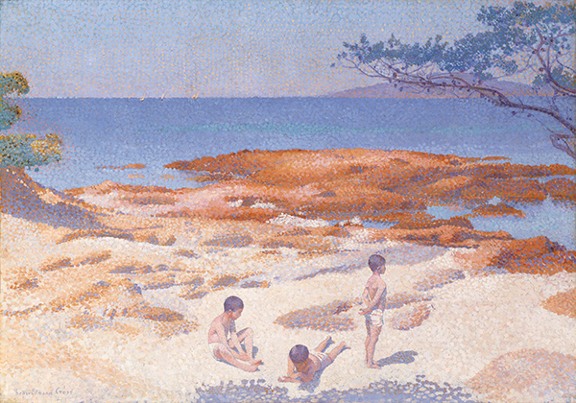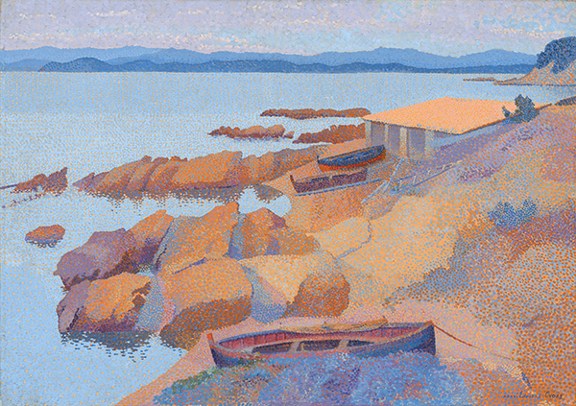Pointillist Henri-Edmond Cross
What better way to anticipate summer than to see sun-drenched paintings from the south of France? Whenever the subject of Pointillism comes up in art history books, there are usually only two major artists represented: Georges Seurat (1859–1895) and Paul Signac (1863–1935). I happen to find a lesser-known, though equally important, artist just as interesting, if not more. His technique was more dot-like than dash-like, and I think his figures are more believable. That artist is Henri-Edmond Cross, whose birthday happens to be the 20th of May.
 |
| Henri-Edmond Cross (1856–1910, France), Beach at Cabasson (Baigne-Cul), 1891–1892. Oil on canvas, 25 ¾" x 36 ⅜" (65.3 x 92.3 cm). Image © 2024 Art Institute of Chicago. (AIC-417) |
In the 1880s, Cross was a founding member the Society of Independent Artists. This group rejected the conservative, traditional painting curriculum of the official art schools in Paris. As a member of the group, he met Seurat, the Neo-Impressionist pioneer, from whom he learned of the Pointillist technique. Cross exhibited his first Pointillist works in 1891.
The following year, Cross moved to Saint-Tropez in Côte d'Azur, Southern France. This town in the French Riviera was favored by many Post-Impressionists for its brilliant sunlight and gorgeous warm weather. Cabasson, the setting for the painting Beach at Cabasson, is not far from Saint-Tropez. In the mid-1890s in Saint-Tropez, Cross developed a looser, broader interpretation of the Pointillist technique, allowing for more individual expression. He also placed more emphasis on color as its own entity rather than being dependent on nature. This greatly influenced future Fauves Henri Matisse (1869–1954) and André Derain (1880–1954).
Like most major art movements grounded in strict theories, Impressionism ran its course as a ground-breaking art movement between the 1870s and the 1880s. By that time, some artists rejected the limited theory of Impressionism that neglected psychological depth and emotional involvement in the work. Post-Impressionists moved away from the momentary, detached mood of Impressionism, which emphasized technical aspects rather than subject.
Post-Impressionists reinvested in subject matter as the focus of works of art, exploring what the very nature of subject and composition should be. Of the many strains of Post-Impressionism, Neo-Impressionism involved a younger group of artists who sought to unite Impressionism's technical emphasis on color and light with a vision grounded in science and the study of optics. In the view of the Neo-Impressionists, the movement was the logical successor to Impressionism.
Cross, born Henri-Edmond-Joseph Delacroix, was born in Douai in northern France. His family moved to Lille in 1865, where his artistic talent was rewarded with drawing lessons from the academic realist painter Charles Carolus-Duran (1837–1917). He subsequently studied with the Realist still-life painter Francois Bonvin (1817–1887) in Paris in 1875, and then with academic painter Alphonse Colas (1818–1887) in Lille in 1878. In 1881, he studied at the School of Fine Arts in Paris.
When he began to paint in earnest for a living, he changed his name to Henri-Edmond Cross so he would not be confused with the famous Romantic painter Eugène Delacroix (1798–1863). At this time, his works consisted mostly of portraits and still life in a conservative Academic palette relying on brown/green/yellow underpainting. His epiphany period came in 1883 when he met Signac and Impressionist pioneer Claude Monet (1840–1926). Cross adopted the bright, pure color palette of Impressionism and an inclination for painting landscapes from Monet.
 |
| Henri-Edmond Cross, Coast Near Antibes (Calanque des Antibois), 1891/1892. Oil on canvas, 25 ⅝" x 36 5⁄16" (65.1 x 92.3 cm). Image © 2024 National Gallery of Art, Washington, DC. (NGA-P0782) |
Correlations to Davis programs: Davis Collections: Pointillism; A Global Pursuit 2E: 7.4; Experience Painting: p. 68; Discovering Art History 4E: 13.2


Comments